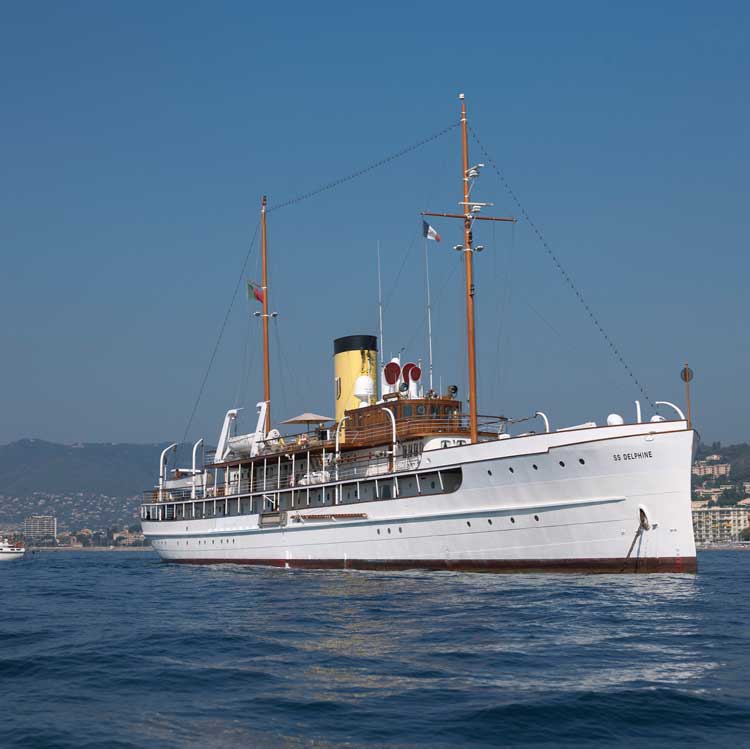A Very Singular Vessel
It is not all the days or even all the years, that a Marine Engineering & Naval Architecture company as TecnoVeritas has the opportunity to participate in such a luxurious vessel live. S.S.DELPHINE is an ocean-going marine engineering museum.
TecnoVeritas involvement was all about the update of S.S. Delphine energy optimization and environment friendliness according to MARPOL annexe VI. The vessel propulsion plant is intact with the two original quadruple expansion steam engines, driving directly their respective propellers. With this project, TecnoVeritas is proving that a ship may not be scrapped due to its age, provided the hull is in good condition, and that vessels as S.S Delphine have their special owners and clientele, both sharing the joy and feelings of a unique vessel.
Oceangoing museum
S.S. Delphine is not a caprice yacht for owners who only want to know where their boat is during Easter vacation. This steel-hull vessel requires a minimum onboard maintenance crew of 5 people whenever she sits idle. Her owner and guests must share the passion to maintain an oceangoing museum fitted with every luxury, navigational and security convenience imaginable.
“Horace Dodge spent $US2 million to build S.S.Delphine,” that according to Mr Bruynooghe says that’s more than $US180 million in 2010 dollars, but she cannot be replicated. Dodge designed and built the steam engines himself and they’re very environmentally friendly.”
Delphine’s pair of 6-foot-tall propellers is powered by 20,000 litres of water converted in steam pressure by diesel fuel. “It’s 19th-century hydrophysic technology that cuts costs and leaves a low pollution signature,” Delphine fuel consumption cut down as well as the improvement of her environment friendliness were the main objectives of the TecnoVeritas project.
The main boilers
SS Delphine is a yacht commissioned by Horace Dodge, co-founder of Dodge Brothers. The yacht was launched on 2 April 1921 and spans 258 feet (79 m). Power was originally supplied from three Babcock & Wilcox boilers[1] powering two 1,500 horsepower (1,100 kW) quadruple expansion engines. In her 2003 refit Delphine was re-equipped with two modern water-tube boilers operating at 20 bars (290 psi), the larger of which has an evaporation capacity of 14 metric tons (31,000 lb) of steam per hour while the smaller can evaporate 4 metric tons (8,800 lb) per hour; these new boilers supply the original quadruple-expansion engines. “Of all the large American-built steam yachts built between 1893 and 1930, the S.S. DELPHINE is the only one left in her original condition with her original steam engines still in service.” The Delphine caught fire and sank in New York in 1926, to be recovered and restored.
She suffered further damage in 1940 when she ran aground in the Great Lakes and was repaired. She was acquired by the United States Navy in January 1942 and rechristened USS Dauntless (PG-61), to serve as the flagship for Admiral Ernest King, Commander in Chief of the U.S. Fleet and Chief of Naval Operations. She was sold back to Anna Dodge (Horace Dodge’s wife) after the conclusion of World War II and restored to civilian standards and service, including her original name.
Delphine changed hands in 1967 and again in 1968, changing names again to Dauntless, only to be sold again in 1986, 1989, and in 1997 – at scrap metal prices to her next owners – who proceeded to restore her for $60 million to the original 1921 condition including interior decor and the original steam engines. She was rechristened S.S.DELPHINE by Princess Stéphanie of Monaco on 10 September 2003. She was recently acquired by its current owners in 2015 and will return to its home port of Monaco for the 2017 charter season.






